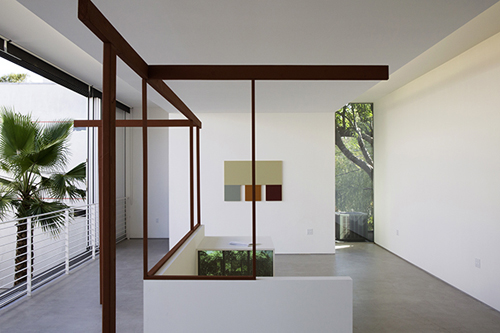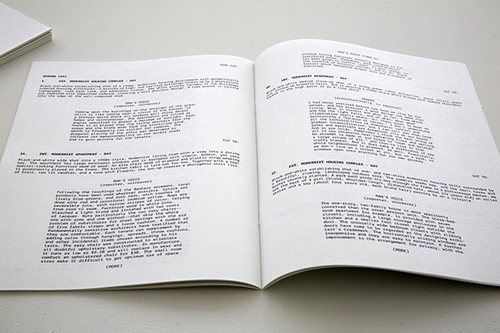[2013 / 2016] 1953. Possible Scenarios of a Discontinued Future
Painted wood, fabric, cushion, rear-projection screen, HD video (23 min), script, poster
Dimensions variable (approx. 435 x 300 x 230 cm)
1953. Possible Scenarios of a Discontinued Future creates a multi-layered investigation into an unrealized social vision for a new modernist utopia—conceived of as a city within a city, for a working class population of 17,000—on the site of the displaced communities of Chavez Ravine, situated just northwest of downtown Los Angeles. Intended as a prototype for future low-cost housing, the controversial project was met with a highly publicized attack on public housing, where anti-socialist polemic, private developers, real estate lobbyists, and the media all came together not only to dominate public opinion, but also to affect the housing debate on a national level. After years of detailed preparation, the visionary plan for Elysian Park Heights was scrapped in 1953, and replaced by plans for Dodger Stadium, and private enterprise in general. The story of this housing project exemplifies the end, as well as the beginning, of a new era. After World War II, the socially concerned modernism of the left emerged from its own battles with a new corporate aesthetic and a much more ambivalent ideology, giving way to neo-liberal urban development practices.
Beginning with present day footage filmed on location at the former site of Neutra's progressive, yet later razed Channel Heights housing project (San Pedro, 1942), a short film traces history forward to the Los Angeles County Museum of Art, a 1947 edition of Woman's Day magazine, Elysian Park and Dodger Stadium, as well as to Neutra's own house, "projecting" the built architecture into the site once designated for Elysian Park Heights. Inserted into an architectural installation based on abstract fragments of Neutra's design, the film is accompanied by a fictional narrative with a script assembled from historic quotes taken from a variety of archival sources. Put into dialogue with one another, the quotes formulate a lively discussion, bringing to life the opposing ideas and heated atmosphere at that specific time. Through this overlap of text, film, and installation, a portrait of an actual, yet imaginary space is created that offers a range of visions relating to the city's geographic and cultural past, present, and future.
"[...] The Occidental division of time into past–present–future is narrated here by Nimmerfall as lying on one spectrum: it is an attempt to use scenario thinking to place points of opening between time and grammatical tense, as well as between the factuality of history and the potentiality of historiography.[...]" – Lisa Stuckey
< Index



